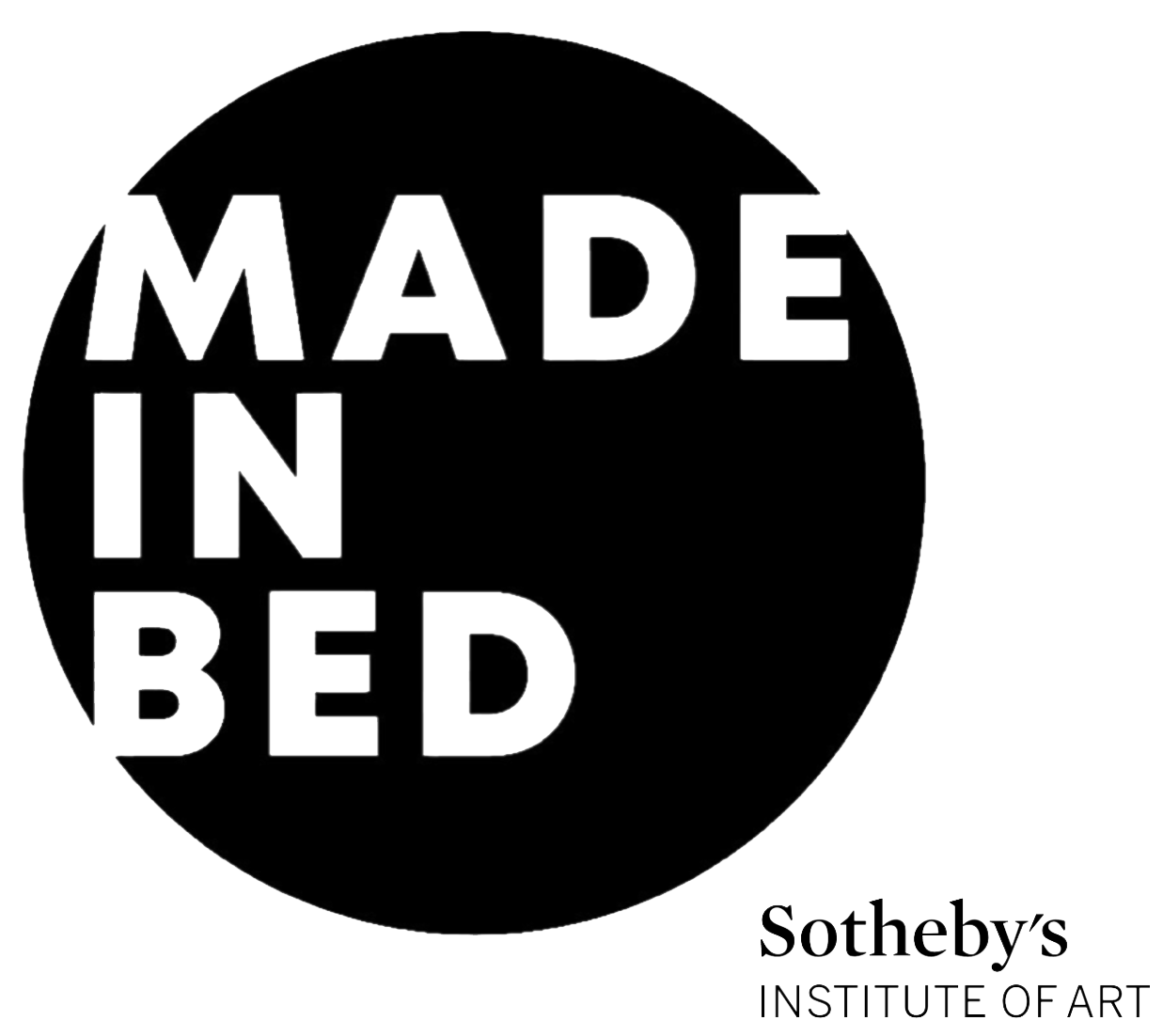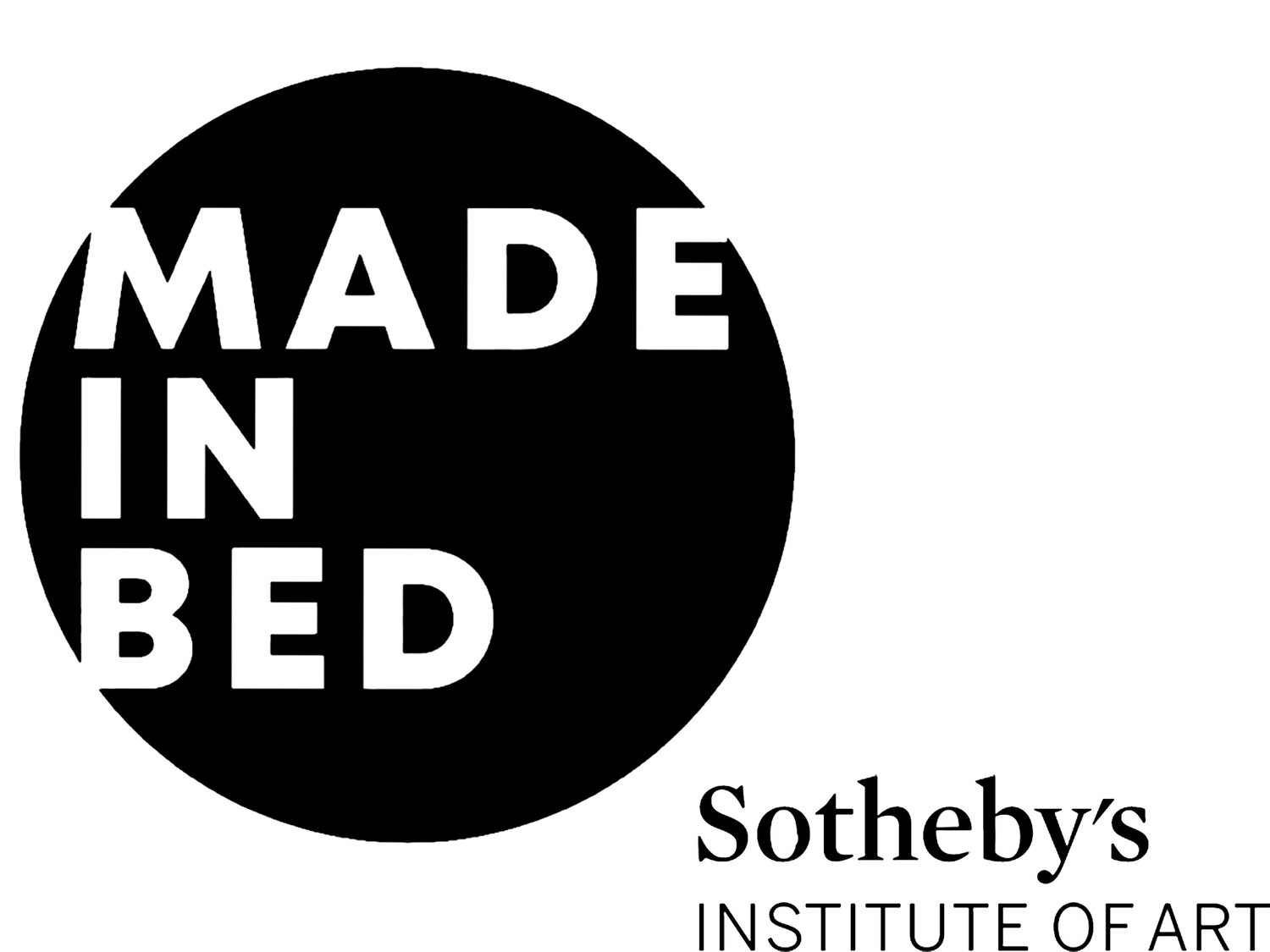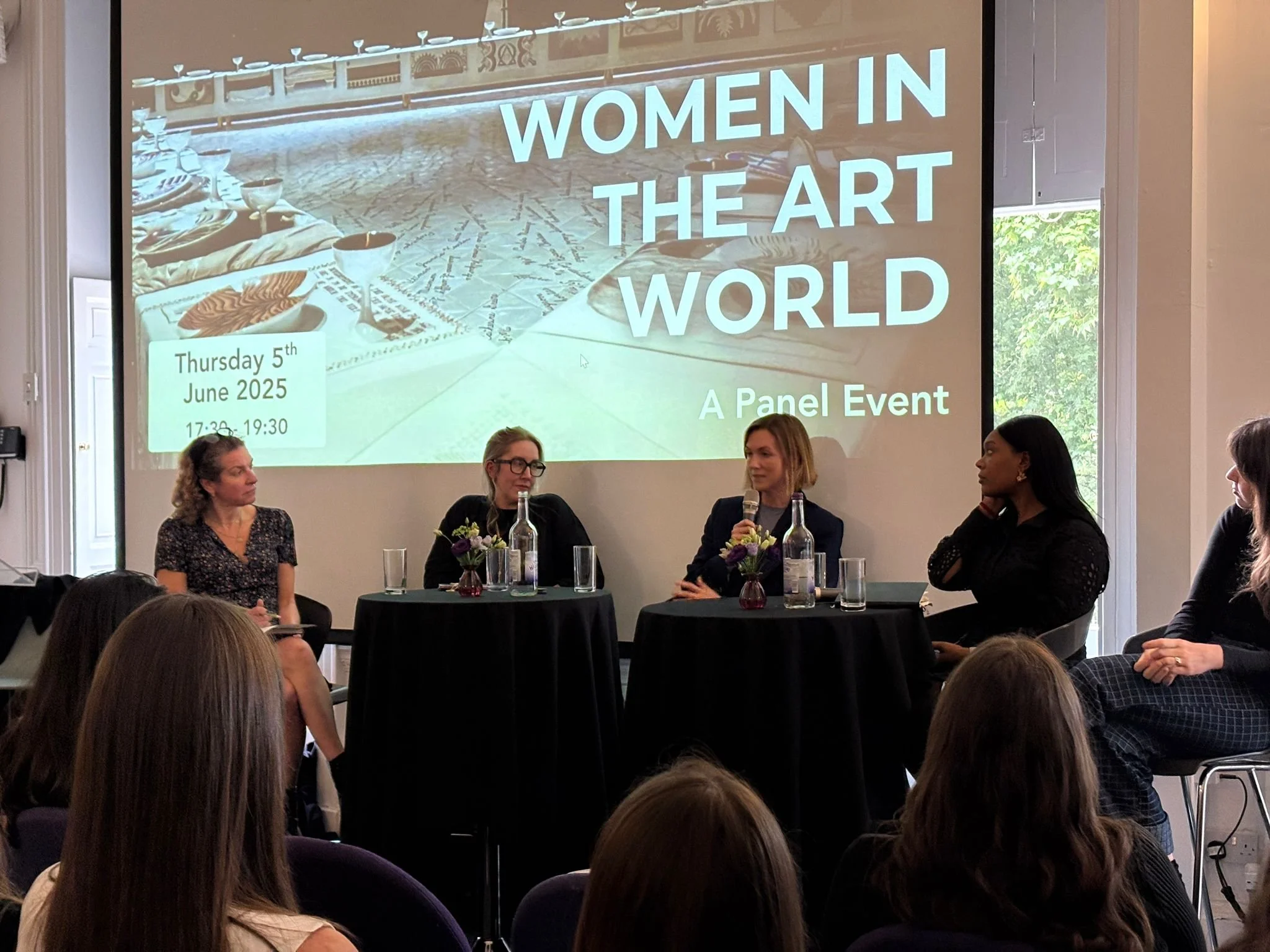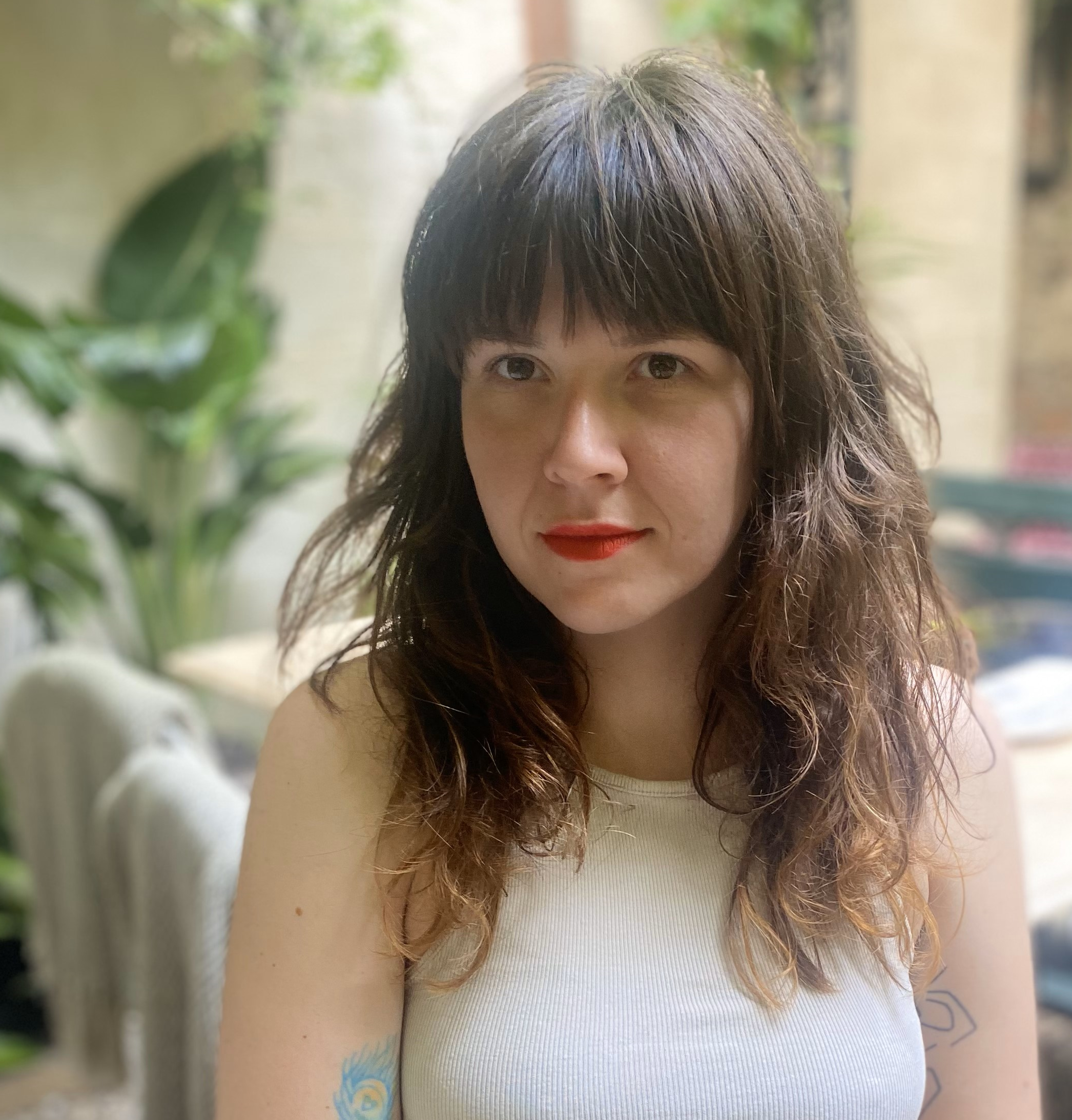The F Word: Fairer Futures for Women in The Arts
With 90% of the cohort at Sotheby’s Institute of Art (SIA) identifying as female, the workplace can feel alien with a stronger male presence. [1] Dr Liza Weber, lecturer on the MA Art Business program, thoughtfully curated a panel of five women working across the art world to provide their insights and advice for this year’s students entering the workforce.
Women in The Art World Panel, Sotheby’s Institute of Art, 2025. Photo Courtesy: Alice Ji-Won Kim.
Melanie Gerlis, icon of art journalism and SIA alumna, served as moderator. Gerlis wears several hats as an art market columnist for the Financial Times, The Art Newspaper’s editor at large, and the author of “The Art Fair Story.” She was joined by Jo Harrison; director at The Approach and co-founder of The Art Working Parents Alliance; Sherece Rainford, Gallery OCA & Gallery Director, Rele, London; Carrie Scott, entrepreneur and founder of consultancy, curatorial, and gallery business, Carrie Scott & Partners; and Gemma Rolls-Bentley, curator, writer, and consultant, specializing in queer art.
Melanie Gerlis. Photo Courtesy of Sotheby’s Institute of Art.
These women may come from a range of backgrounds, but what unites them is their positions of influence and leadership in the art world. The panel opened by discussing career journeys and how the panellists felt their womanhood factored throughout.
Jo Harrison.
Jo Harrison began studying fine art at Goldsmiths and expressed that she was “not as good at making art as she was at thinking about it.”[2] Her first art world job, like many, was an unpaid internship at a blue-chip gallery in London. In terms of being a woman in this career, she divulged feeling passive when interacting with winking clients. While working at this gallery made Harrison aware of her position as a woman in the arts, it also highlighted class difference, something she noticed having had attended a comprehensive school and coming from a single parent household. She had to work nights in a local pub to make ends meet, whereas those from more privileged backgrounds are able to conduct unpaid work with little financial stress.
Harrison also explores the idea of social reproduction. This is the invisible labour that goes into maintaining ourselves day-to-day, whether it be social in terms of childcare, or infrastructural, such as hospitals and schools. This often-invisible labour is termed as a “labour of love.” It seeps into the art world through unpaid internships because it is a path driven by passion. If you work in the arts, you are lucky to do what you love, and you pay…by not being paid much at all. This serves as a barrier to access for those who cannot afford to work unpaid. She tied this back to womanhood because labours of love are often associated with the unbalanced domestic labour conducted by women, serving as an added pressure on top of working. As a result, women need to get comfortable with the F word: Fair. Fairness in pay is not to be shied away from despite the art world’s tradition of underpaid and undervalued labour. Fighting for what is fair is a means of changing the way art world work is valued to create a more financially accessible future work environment for everyone.
Sherece Rainford. Photo Courtesy of Lewis Patrick.
Sherece Rainford described her journey as unconventional. Studied Business Studies, PR & marketing and worked in this area, within local government, start-up business, as a lecturer at UCL, and as head of operations for an IT company. Her move into the arts was personal. Rainford described feelings of homesickness regarding her Jamaican background. Despite accumulating several souvenirs from her travels, she never brought anything back from Jamaica because she knew she would return. On her quest to remind herself of home, she realised that there was a wealth of great Caribbean artists she had not been aware of. She recalls asking friends and family to name Caribbean artists with the answer often being music related. Rainford founded OCA (Of Caribbean Art) to remedy the lack of awareness about the wealth of visual artistic production in the region.
The main hurdle for Rainford’s career was the imposter syndrome that came with not having the same arts background of her peers. However, she quickly realised that art is like any other business, and she was blessed to have the passion alongside business savvy from her previous work and life experience. This allowed her gallery to accelerate at a quicker rate than other art startups might. Rainford says this imposter syndrome may have been compounded by the fact that among her peers she was usually not only the only woman, but also the only woman of colour. She notes that, of those in attendance to the panel, she was the only Black woman in the room. She explores the potential limitations we may place on ourselves due to lack of representation. With the systemic hurdles put in place, the lack of representation of marginalised groups in leadership positions can create a lack confidence in someone’s ability to occupy these roles. Rainford says that she is happy to be a woman, especially in a position of leadership as she can serve as a model and example for other women to have the confidence in themselves to seek out these positions, even though it can be intimidating and they may be in the minority. As the artist Basil Watson, told her: “An elephant can be eaten, but one bite at a time.”[3]
Carrie Scott. Photo Courtesy of The Wick Culture.
Carrie Scott began at Conde Nast and expressed a distaste for corporate America. She returned to graduate school, pursuing a degree in Art History to write about travel from an arts perspective. Scott explored the lack of support from fellow women in the workplace, as well as how motherhood affected her journey. She stated that she and her husband, who works in finance, were equal earners before parenthood. After the birth of her first child her salary took a 25% hit, while her husband’s increased. This pattern continued with her second child too. Scott’s role as a business owner also played into this salary hit. With less time on her hands, she had to hire more people, which led to a decrease in salary dividends. When pitching an interview series to top television execs after the birth of her second child, she was told by another woman that “at her age her window of opportunity was too small.”[4] Scott explores the notion of women blocking each other, whether it be out of jealousy or out of a need for others to struggle because they struggled. It demonstrates how internalised misogyny prompts women to discourage each other. She highlighted the importance of frankness on these topics to call out all bad behaviour, from men and women alike. It can also create a greater sense of community for women to question their own attitudes and support of one another.
Gemma Rolls-Bentley. Photo Courtesy of The London Art Fair.
Gemma Rolls-Bentley spoke to her experience as a queer woman working with LGBTQ+ artists. She began at Edinburgh University, majoring in maths and minoring in AI and art history. Her experience studying art history for the first time spurred her to change her degree. She began curating as a student, following the connections she made with friends studying fine art. She humorously recounted curating her first show at an abandoned newsagents, spending the £100 cheque from the University on wine to encourage attendees. Art played a crucial role in her understanding of identity. She recalls a Catherine Opie exhibition with its depiction of leather lesbians and “dykes on bikes” and realizing this was her community, attesting to the power of representation. It is important to platform a more diverse range of artists and arts professionals, so that others can explore their own identities and gain the confidence to seek out the positions they desire.
As the only panellist with a wife, Rolls-Bentley says she often hears women expressing their wish to be married to a woman when it comes to having a partner that champions their career and shares the workload. Rolls-Bentley rightfully disregards this as a cop-out. There is no reason that men cannot support their partners in the way that women do. This lack of support from men boils down to their lack of understanding. Women have often been encumbered with the misogynistic belief that they have to choose between children and a career. Men are not burdened with this dilemma, and often have both easily and without qualm.
Harrison stated that the top 10 selling living male artists have thirty-three children collectively. Meanwhile, the top 10 selling living female artists have only three among them. Fatherhood has in no way hindered the careers of male artists, with their making up 68% of the artists represented by top London galleries as of 2019.[5] The figures for women are much lower, especially for women of colour. The Burns Halperin Report explores representation of Black American female artists, with dismal results. Between 2008 and 2022, works by Black American female artists totalled a mere 204 million USD, making up 0.1% of total auction sales. [6]Rainford responded with resignation to this figure. She said it should be shocking, but it is unfortunately predictable. This is not because there is a lack of great Black artists (there is not, she clarified), but that there is something institutional blocking them from succeeding.
Worldwide Auction Sales 2008 - Mid 2022, Graphic by Nehema Kariuki. Courtesy of the Burns Halperin Report 2022 and Artnet Analytics.
The panellists were vocal about the need for institutional change. The first step is moving these discussions beyond a panel and into boardrooms where change can be made. It is one thing to acknowledge injustice and share experience among each other as women as a means of support. It is important now to take action to prevent stagnation and to make those who do not experience injustice aware of it. It is crucial to make those in positions of leadership with the potential to create change aware of it. Another step we can take towards change is supporting female and queer artists. Scott calls for everyone to “put your money where your mouth is, even if your money is small”.[7] Change begins in your own backyard, and one can make small steps toward improving the market and demand for female artists by investing whatever possible in them. It may seem daunting to change the nature of the workforce and to create a more accommodating art market, but to echo Basil Watson’s words of encouragement: an elephant can be eaten, but one bite at a time.
Edwina Keary
Art Markets Co-Editor, MADE IN BED
Footnotes
[1] Dr Liza Weber, Women in The Art World, Sotheby’s Institute of Art, Thursday 5th June 2025.
[2] Jo Harrison, Women in The Art World, Sotheby’s Institute of Art.
[3] Sherece Rainford, Basil Watson, Women in the Art World, Sotheby’s Institute of Art.
[4] Carrie Scott, Women in The Art World, Sotheby’s Institute of Art.
[5] Dr Kate McMillan, Representation of Female Artists in Britain During 2019, Freelands Foundation, 2020.
[6] Julia Halperin and Charlotte Burns, The Burns Halperin Report, 13th December 2022.
[7] Carrie Scott, Women in the Art World, Sotheby’s Institute of Art.








